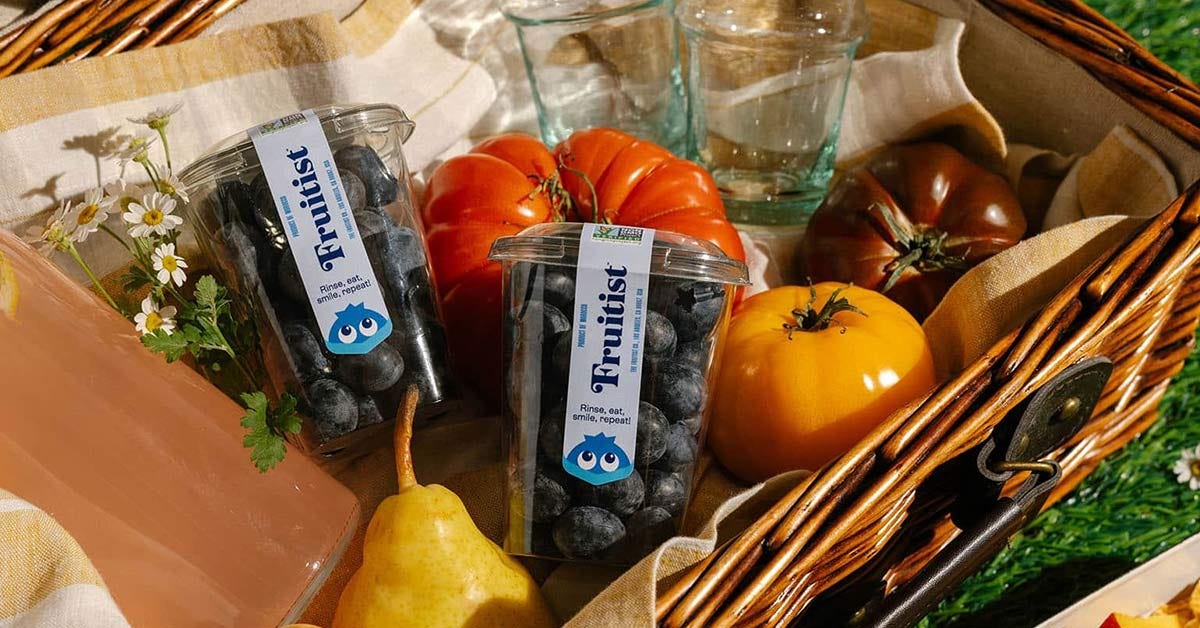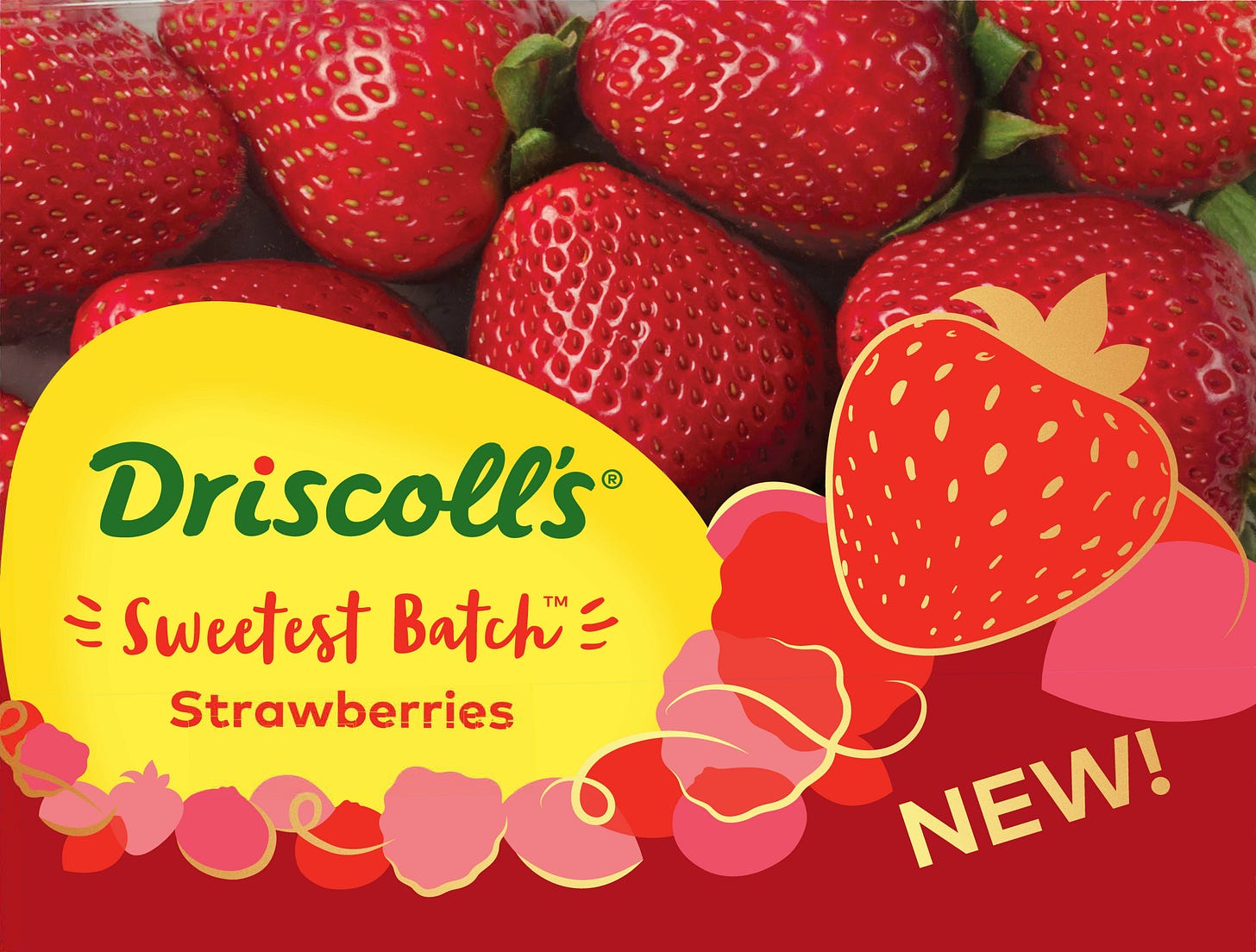You don’t have to be accepted into the LEAP program to get into Whole Foods
Plus, I guess commodity branding is in
In this post:
On getting into Whole Foods, the SVP wants to know — Can you run a business, not just sell a product?
The newsletter I cancelled two other newsletters for
Can produce have a brand promise?
Let’s go —
🫐 Are produce companies snack brands now?
Stewart Resnick, of The Wonderful Company, used to say, “you don’t have a brand, you have a label!”, referring to competitors. It was a slight that meant they had not built anything anyone cared about. They had not built brand equity.
Now Fruitist is out here talking about berries as snack foods that deserve CPG-style marketing, and Driscoll’s has hired its first CMO.
What these companies are basically saying is, we own the supply chain, breed the fruit, invest in tech, and control quality… why not invest in brand.
Arguably Driscoll’s, the best known berry company, has brand awareness — people recognize it — but awareness is not equity. Awareness does not connect with the consumer on an emotional level. This is also produce. It bruises and spoils and nothing changes the fact that sometimes the clamshell you buy is delicious, and sometimes it’s mush.
So now these companies are trying to do like CPG —make you care. Create meaning around something you used to buy purely on sight and price.
Tell me I’m wrong but to make this work you guys have to have flavor guarantees, premium formats, and a brand promise. I will say Driscoll’s Sweetest Batch might make me a believer.
Still, the fact that global berry producers are hiring CMOs and talking about whitespace like startup founders tells me one thing: the commodity guys want in.
📰 I cannot read one more newsletter
If you are like me, you’ve hit your max on newsletter subscriptions. I’ve unsubscribed from two so I could add this one: The Bylders Newsletter. It’s an essential read for D2C and online retail brands doing at least $100K/mo revenue and moving up quickly. It’s for founders who are still hands-on, or for ops leaders like COOs. And it’s free. (I do not get paid to say this. I do not do paid ads here.)
Take, for example —
What makes this piece stand out is that it breaks apart the exact point where most D2C / online retail brands hit a wall, and shows you why just hiring more freelancers or launching more ads will eventually stop working. And they don’t just say “you need better data” or “optimize ads.” They walk you through which systems to build, in what order, and how to make them foundational so scaling doesn’t blow up your margins.
🛒 You don’t have to be accepted into the LEAP program to get into Whole Foods
I sat down with Alyssa Vescio, SVP at Whole Foods Market, who oversees local and emerging brands, all the category merchants for center store (everything from dairy to beverages to pantry staples), and private label. She basically runs the show over there.
We talked about how most brands dream about being accepted into one of Whole Foods’ formal tracks for emerging companies, and while yes those tracks are incredible, most brands don’t come through them, and that what makes brands coming into Whole Foods successful is not necessarily LEAP.
LEAP is Whole Foods’ accelerator and runs two tracks:
Early Growth: Over 1,500 brands applied this year. Foragers reviewed every single one and about 10 are selected for a 14-week program
On the Verge: For brands already in Whole Foods, nominated by foragers as “ready to grow.” Different curriculum, same 14 weeks, built for scaling fast.
Amazing if you get in—but not the only path. Many brands are discovered at shows, through the supplier portal, or just by relentless hustle.
I wanted to know, once you’re on shelf what keeps you from flaming out? Alyssa’s advice boils down to three things:
Drive trial. Demos, promos, discovery spaces — Discovery spaces are off shelf displays, and some are granted vs paid — and WFM is rolling out new ones soon, so stay tuned.
Operations and cash flow. Inventory, funding, and cost structure. Can you run a business, not just sell a product?
Contingency plans. Because things will go wrong. The brands that survive are the ones with a Plan B. (I talk about this a lot on these pages — supply security, day-of production management, knowing how to avoid/do a recall etc)
What struck me was how often Alyssa said that the second part—operations and cash flow — is what trips brands up the most. It seems like she kinda knows a lot of brands are operating wild and thin (and having had a peek under the hood of many, I can confirm).
She kept it really positive and so did I, but underscored how chancy it is to say yes to Whole Foods (or any retailer), and not have your business operations tight.
All my best,
Jennifer






I love the team at Driscolls. They are innovative, consistent and sustainably focused. They are getting absolutely hammered right now by the citizens of Watsonville about their conventional farming near schools. I sympathize with the community members and look forward to the resolutions put in place. We MUST find ways to fund research for alternatives to soil borne pathogens and pests so we continue to grow the best and safest food supply in the world. California is home to more strawberries than any other growing region and I hope that never changes!